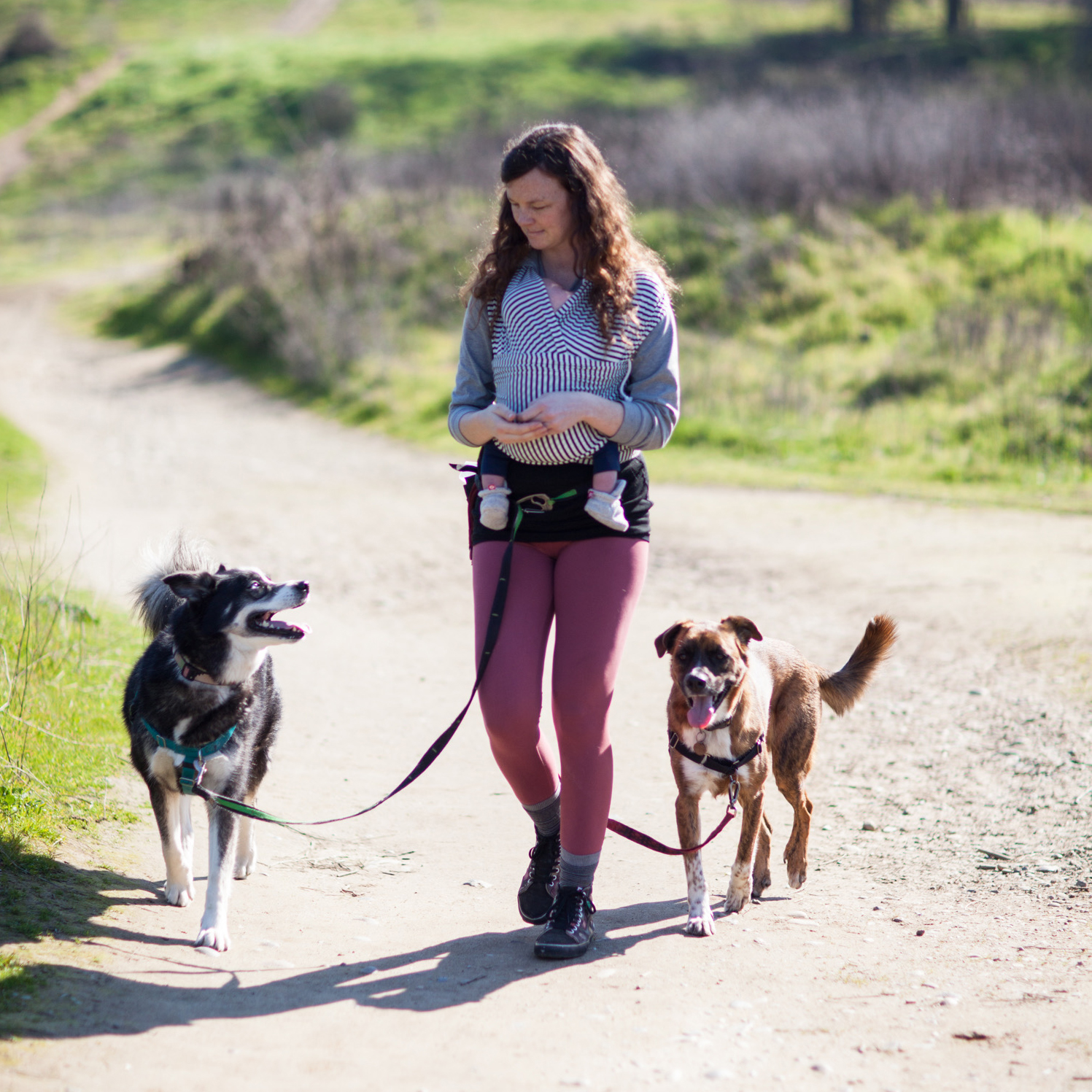What is counter-conditioning and how to use it to teach your reactive dog to expect positive, good things when your dog sees a trigger.
Now that we've talked through management to set up your dog for success in potentially reactive situations (earlier in the Reactivity Channel) and you have your management plan in place, we're ready to get into the heart of helping change your dog's emotional response to triggers with a behavior modification program.
There are two tried-and-true ways positive reinforcement dog trainers help reactive dogs go from a fearful, negative response to positive and calm: counter-conditioning and desensitization techniques.
These two dog training concepts go hand-in-hand, but we’re going to break each of them down in their own step-by-step guides.
Let's jump into counter-conditioning first.
Your Dog's Plan
Stop! Don't read this long article. Instead, get everything you need to know, including all advice on Reactivity Training, in a customizable step-by-step plan for your dog created by our community of certified trainers and nutritionists.
What is counter-conditioning?
Counter-conditioning is the process of changing the emotional reaction of a dog to a particular trigger or scary thing by pairing the presence of that trigger with really desirable things. In our dogs' cases this means FOOD. Really, really good food.
Most of us, whether dog trainers, dog owners, or not, learned a little bit about Pavlov’s dogs and classical conditioning when we were in school. In his famous experiment, Pavlov would ring a bell before presenting dogs with food. With time and repetition, the sound of the bell ringing would elicit the same response as the food itself - salivation.
How do you take your dog from "OMG TERRIFYING 2-WHEELED THING COMING AT US!" to "Hey, it's a bike, where's my chicken?"
That’s essentially what we’re doing here with this behavior modification. We’re less interested in the salivation aspect, and more interested in the association of good things using the same technique. By creating training set-ups in which our dogs are exposed to a trigger from a distance/intensity that still allows them to remain under threshold, and then pairing those exposures with our dogs’ favorite high-value treats, we teach them that the scary thing is actually a predictor of their treasured snack.
Most dogs who are reactive are fearful dogs.
Fear is a powerful emotion. With counter-conditioning, we're gradually changing your dog's emotions when your dog notices a trigger. That, in turn, changes your dog's behavior (the outward expression of your dog's reactive feelings). Any positive reinforcement certified professional dog trainer will tell you that building up positive associations consistently and gradually can change how your fearful dog feels and reacts to triggers.
With time, this changes your dog's emotional state from reacting to the scary thing to looking at you for the chicken (or whatever super-valued treat you use), the much-coveted good thing that appears magically at every scary thing sighting.
You're changing your dog's expectations. And of course, that changes your dog's negative feelings and how your dog reacts.
Try this
To make sure the trigger becomes a predictor of good things, the trigger MUST appear FIRST. And the food must also stop when the trigger is no longer perceptible. That's part of the magic.
There are a few rules for counter-conditioning to be successful:
- The trigger must not be scary (or at least, scary at that distance/intensity).
- The scary thing must predict something good. This is why chicken when your dog sees a trigger works so well - chicken doesn't come out unless that trigger does!
- The treat you use must be the ultimate doggie equivalent of chocolate covered french fries with a side of cheeseburgers. This is no time for kibble (unless your dog thinks it's the best thing ever) - we're talking about amazing, something-over-the-top special.
- You must be consistent and patient. Counter-conditioning can take time, depending on how many triggers your dog has and how intense his/her reactions are to them. But stay the course, and you will see changes in your dog's emotional state with consistent counter-conditioning.
You want your sequence to look something like:
Other dogs or a dog appears at 20 yards -> give chicken -> other dogs or dog turns corner out of sight -> chicken ends.
What you don't want it to look like:
Chicken -> appearance of other dogs -> more chicken -> other dogs disappear -> still chicken.
While the second scenario may work to help reduce the likelihood of your dog's reacting because he or she is busy eating chicken the entire time, it is not helping your dog to learn that the other dog's presence is the reason for the chicken.
That being said, if the other dog (or whatever the trigger may be) is unexpected (i.e. not part of a training set-up, but a result of a fluke in management), and you just need to get the heck out of there, don’t worry too much about the order of operations. It’s okay to feed as much chicken as you need to make a getaway.
Reactivity Training
Interested in Reactivity Training? Follow topics you're interested in to customize your dog’s step-by-step plan so it's most helpful and tailored to your dog when you're ready to get started.
How to deal with triggers that are already predictors
Some triggers are already predictors, like, say the doorbell, which is a predictor of a person entering the house. In these cases, it can help to change the already learned association, too. What does that mean?
Try this
Replacing the already learned association (doorbell = people at the door) may mean doing doorbell -> chicken many, many times without there ever being a person entering your home.
By separating the doorbell sound from the person entering your home, we can work on those things as two separate triggers and get really strong with them before we try to combine them.
This goes back to management - it may mean having guests text you ahead of time upon arriving and going outside to greet them with your dog, or having your dog in a back bedroom with a sound machine as the guest arrives, or something along those lines.
What counter-conditioning success looks like in your dog
When your counter-conditioning dog training is working, you’ll see something called a conditioned emotional response. This is the “hey where’s my chicken?” moment.
It usually looks like a dog notices a trigger and then turns his/her head to you in anticipation of the expected treat. You may see your dog’s ears perk up, or a little tail wag. Some dogs will even choose to look toward the trigger and then immediately back to you again for that goodie.
These little moments are progress. It's important to recognize them when they do happen – our dogs notice these tiny changes in behavior and we should too!
Remember: Counter-conditioning is NOT contingent on your dog’s response!
We are not only offering food when your dog does not react. If your dog reacts in the presence of the trigger you are counter-conditioning for, this is information that you need more space BUT YOU STILL OWE YOUR DOG THE FOOD.
This is different from teaching a specific operant behavior (like teaching sit or recall, for example, when we treat as a reward the moment a desired behavior happens). With counter-conditioning, we are using the high-value treats to create and build an association that changes your dog's emotional response.
Reactivity
Need more advice? Browse all guides in the Reactivity Channel on topics like Managing Reactivity, Reactivity Training, Leash Reactivity, and Understanding Reactivity - created by our community of certified experts for you and your dog.
How long does counter-conditioning take?
The answer is, it depends.
The rate at which your dog makes progress will depend on:
- How well you manage triggers
- How gradual you are in increasing trigger intensity (or decreasing distance)
- How consistent and frequent your training sessions are
- Your dog's individual temperament and history
With all of that said, we tend to see the best results when we consistently set up our dogs for success and are patient with the process.
Keep in mind...
While counter-conditioning is a powerful tool for changing your dog's emotional response to triggers, it is not a quick fix. It takes time and patience to see real progress. But, if done correctly and consistently, you will see gradual changes in your dog's behavior and emotional response.
Keep working on those training set-ups and always have plenty of high-value treats handy for your dog's "OMG TERRIFYING 2-WHEELED THING COMING AT US!" moments. With time, patience, and positive reinforcement, you can help your dog overcome their fears and enjoy a more peaceful life full of good things.
It's important to remember that every dog is different and may respond differently to counter-conditioning.
Your Dog's Plan
Stop! Don't read this long article. Instead, get everything you need to know, including all advice on Reactivity Training, in a customizable step-by-step plan for your dog created by our community of certified trainers and nutritionists.
The bottom line of counter-conditioning:
- Counter-conditioning is all about changing your dog's emotional response to triggers from fearful or reactive to positive and calm
- It pairs the presence of a trigger with really desirable things, like chicken or cheeseburgers
- It takes time, patience, and consistency to see real progress in your dog's behavior
- Success looks like a conditioned emotional response - your dog turning to you for their treat when they notice a trigger
- Training sessions should be frequent and consistent in order to see the best results
- Every dog is different, so it may take longer for some dogs to see progress in their counter-conditioning journey
- Remember to always have plenty of high-value treats on hand for training set-ups and when out and about with your dog - you never know when a trigger may appear. So, keep working hard, stay patient, and celebrate every small success along the way!
Next up in the Reactivity Channel on Dogly
Now that you know how to support your dog with counter-conditioning to expect good things around triggers, stay tuned for more with counter-conditioning's quiet cousin, desensitization, up next.
If you have any questions on reactivity and your dog, just ask us in our Community Discussion. Continue in our Reactivity Channel where you'll learn everything you need to know for your dog from our community of Dogly Training Advocates.
If you ever need more personalized guidance, get started in your dog's training plan here.

